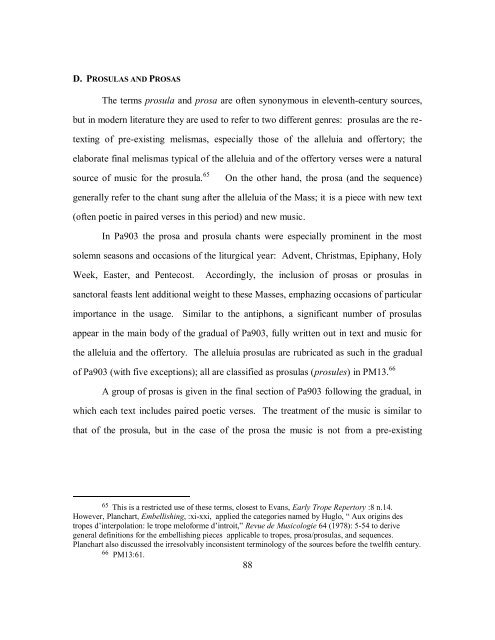Front Matter Template - The University of Texas at Austin
Front Matter Template - The University of Texas at Austin
Front Matter Template - The University of Texas at Austin
Create successful ePaper yourself
Turn your PDF publications into a flip-book with our unique Google optimized e-Paper software.
D. PROSULAS AND PROSAS<br />
<strong>The</strong> terms prosula and prosa are <strong>of</strong>ten synonymous in eleventh-century sources,<br />
but in modern liter<strong>at</strong>ure they are used to refer to two different genres: prosulas are the re-<br />
texting <strong>of</strong> pre-existing melismas, especially those <strong>of</strong> the alleluia and <strong>of</strong>fertory; the<br />
elabor<strong>at</strong>e final melismas typical <strong>of</strong> the alleluia and <strong>of</strong> the <strong>of</strong>fertory verses were a n<strong>at</strong>ural<br />
source <strong>of</strong> music for the prosula. 65 On the other hand, the prosa (and the sequence)<br />
generally refer to the chant sung after the alleluia <strong>of</strong> the Mass; it is a piece with new text<br />
(<strong>of</strong>ten poetic in paired verses in this period) and new music.<br />
In Pa903 the prosa and prosula chants were especially prominent in the most<br />
solemn seasons and occasions <strong>of</strong> the liturgical year: Advent, Christmas, Epiphany, Holy<br />
Week, Easter, and Pentecost. Accordingly, the inclusion <strong>of</strong> prosas or prosulas in<br />
sanctoral feasts lent additional weight to these Masses, emphazing occasions <strong>of</strong> particular<br />
importance in the usage. Similar to the antiphons, a significant number <strong>of</strong> prosulas<br />
appear in the main body <strong>of</strong> the gradual <strong>of</strong> Pa903, fully written out in text and music for<br />
the alleluia and the <strong>of</strong>fertory. <strong>The</strong> alleluia prosulas are rubric<strong>at</strong>ed as such in the gradual<br />
<strong>of</strong> Pa903 (with five exceptions); all are classified as prosulas (prosules) in PM13. 66<br />
A group <strong>of</strong> prosas is given in the final section <strong>of</strong> Pa903 following the gradual, in<br />
which each text includes paired poetic verses. <strong>The</strong> tre<strong>at</strong>ment <strong>of</strong> the music is similar to<br />
th<strong>at</strong> <strong>of</strong> the prosula, but in the case <strong>of</strong> the prosa the music is not from a pre-existing<br />
65 This is a restricted use <strong>of</strong> these terms, closest to Evans, Early Trope Repertory :8 n.14.<br />
However, Planchart, Embellishing, :xi-xxi, applied the c<strong>at</strong>egories named by Huglo, “ Aux origins des<br />
tropes d’interpol<strong>at</strong>ion: le trope mel<strong>of</strong>orme d’introit,” Revue de Musicologie 64 (1978): 5-54 to derive<br />
general definitions for the embellishing pieces applicable to tropes, prosa/prosulas, and sequences.<br />
Planchart also discussed the irresolvably inconsistent terminology <strong>of</strong> the sources before the twelfth century.<br />
66 PM13:61.<br />
88

















